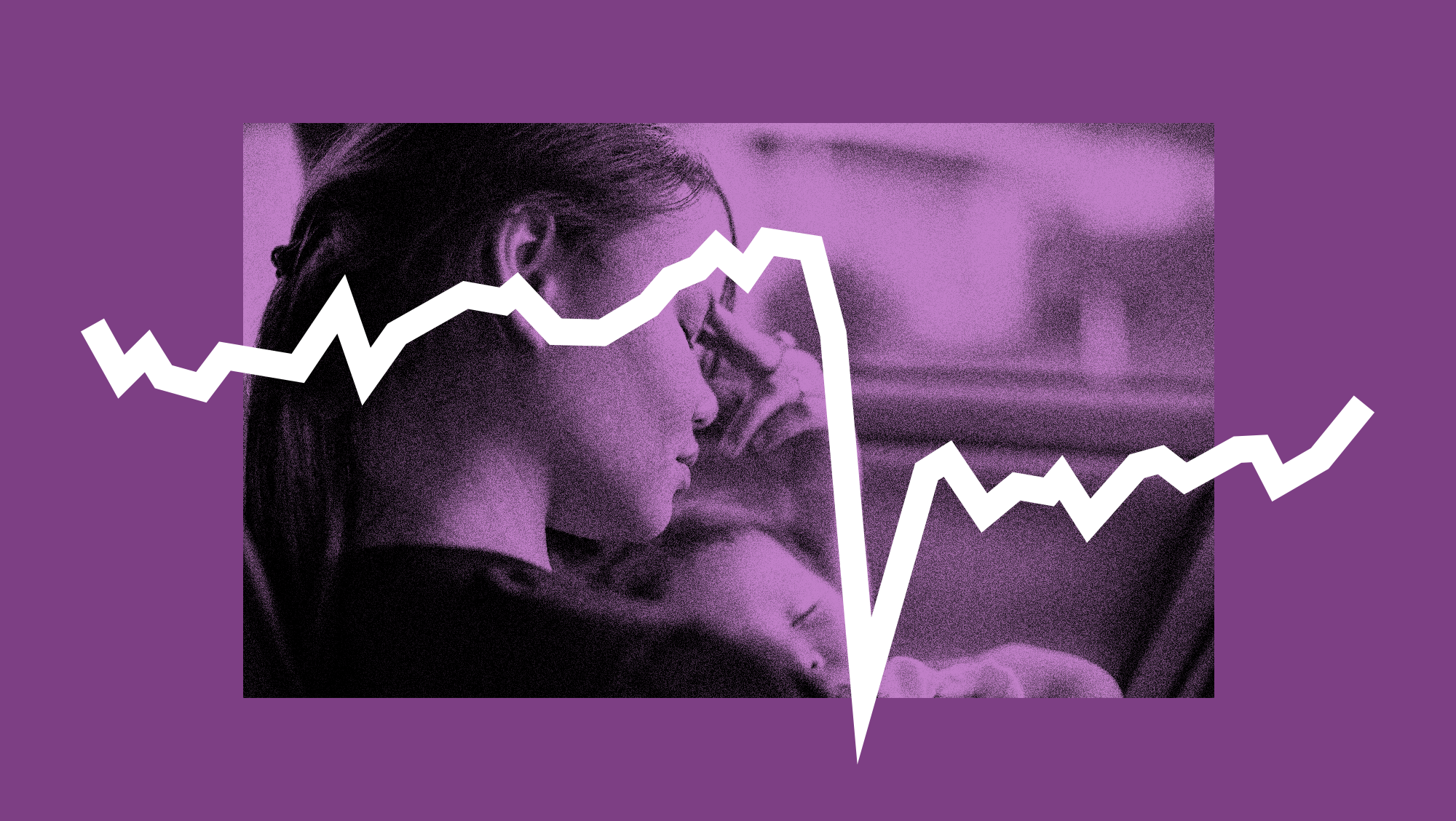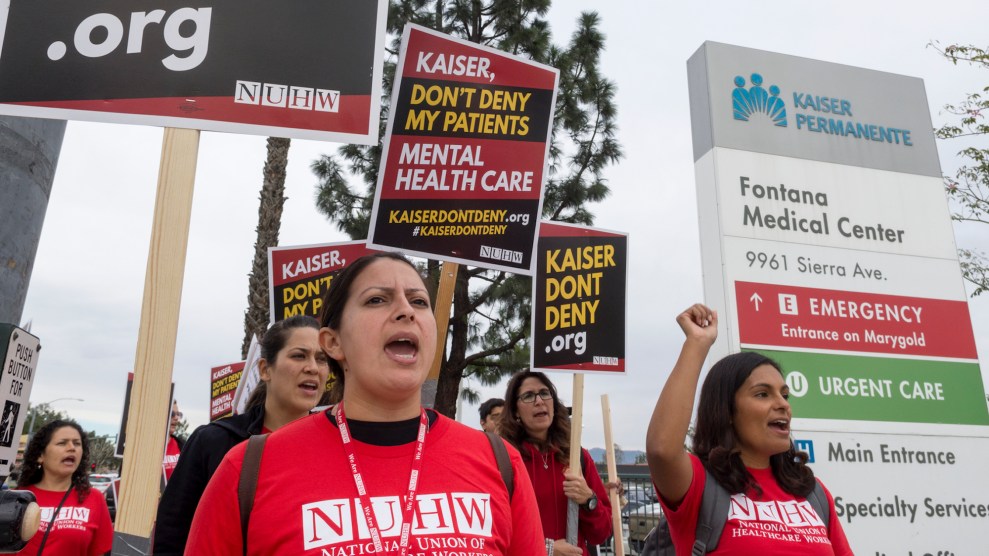In our January + February 2022 cover story, we attempted to answer a simple question: What the hell happened to labor since the pandemic began? It wasn’t one thing. But this package—through a series of worker stories as told in their own voices, interviews with experts, and dissections of media narratives—attempts to make sense of the moment. You can find the full package here.
When the pandemic first struck, droves of people lost their jobs—especially women. Their unemployment rate rose to 16 percent—more than 2 percent higher than for men.
But it didn’t stay that way for too long. Women’s unemployment rate has since dramatically fallen, dipping below men’s for much of the pandemic. At the same time, though, there are still millions of women who have not rejoined the workforce: Their labor force participation is the lowest it’s been since 1988.
So, how can we make sense of this? Certainly, part of what’s driving this mixed economic picture is a broken care economy. It’s a multipart problem: Disproportionately, those who work in care—from child to elder—are women and they’ve lost or left their jobs at alarming rates. And as the care economy worsened under the stress of the pandemic, women have also been the ones typically to pick up the unpaid labor, filing in the gaps at home or with family when paid care is hard to find.
This has all culminated in one fairly dominant narrative: that without child care, women quit. Yes, some of that happened. But to think solely in this framework obscures the more nuanced reality. Women quit for a lot of reasons—some good, some bad, and many times a mixture of both. Since a great deal of women work in the broader service economy, which has been hit the hardest by Covid, many women lost their jobs and have since, as the economy has reopened, found new work. At the same time, there were also women forced to keep their jobs while juggling care, without the luxury to quit and lose precious wages and health coverage. And then there were some women who were fortunate enough to quit for a new job with higher wages—a sign, in fact, of a healthy economy and part of a remarkable pandemic success story.
In short: There is not one way work changed for women because there is not one singular “woman” working in our economy. To better understand how women have rebounded in the pandemic economy, and where they’re still falling short, I recently caught up with Betsey Stevenson, a labor economist at the University of Michigan who focuses on women in the workforce. She talked about the need to change the care economy, the many uncounted career sacrifices facing parents, and the reasons why labor force participation might not be the best metric to consider women’s success. This interview has been edited for clarity and condensed.
Right at the beginning of the pandemic, there was this very sharp rise in unemployment among women. How would you characterize that first initial Covid shock, and specifically how it affected women in the workforce?
I’m glad that’s where you’re starting. Typically, in a recession, what we see is that it’s the goods-producing sector that gets the brunt of the layoffs. As the economy enters a negative territory, people tend to put off any big purchases. You put off making that new car purchase or a new sofa purchase or new appliance purchase. But you typically continue to get your haircut.
The pandemic was the opposite.
The pandemic created a recession that was different from any recession the United States has ever had before—because it focused on, at least temporarily, ending jobs in which people interacted with other people. And that’s the service sector.
Now, the thing about the service sector is this: The service sector is 80 percent of our private sector economy. And the majority of the employees in the service sector are women.
So, basically, when we looked at the very beginning of the pandemic, the industries that got hit the absolute hardest were the ones where women disproportionately work; sectors like leisure and hospitality lost the most jobs. But it was actually worse than that.
Within each sector that lost a lot of jobs, there was also even more women who lost jobs than their share of employment in the sector. Even though women held 78 percent of the jobs in education and health services prior to the pandemic, they lost more than 78 percent of the jobs during the pandemic in education and health services. We sort of saw that across the board. And I think that really is because even within the sector, women are more likely to hold the jobs that require face-to-face human contact—and those are the people who lost jobs.
I think that’s been one of the dominant narratives—at least when economists talk about the Covid shock and how it affects women—the changes in the industries in which they work. But, at the same time, at least anecdotally, a lot of the discussion has been about the lack of child care. Are those two different stories? The same one?
With care, there’s kind of a chicken-and-the-egg thing. Education and health services includes 30 percent of all women working in the private sector. It’s been a driver of job growth for women over the past several decades. It’s huge.
So, there has been a slow return of women to jobs in child care and residential nursing—and care is also one of the reasons that we haven’t seen it. That’s a problem that’s going on here. We’re not seeing women go back to jobs in nursing and residential nursing and child care—and what that likely means is there is some woman who is at home providing care for her child or for an aging loved one that would have, pre-pandemic, given care as a professional.
I think that's how I reconcile it: There are still many people who are unable to return to work because of the fact that they need to provide care. It's not all child care. Some of it is elder care or adult care for people with significant health needs.
The rebound after that drastic shock has been better than we'd expect for women. Many are coming back to work, it seems. Which is what is confusing to me. If care is the primary thing holding people from going back to work, how are so many women able to return to work? So, my question is: Is the crisis of care we’re seeing best understood as keeping people out of work? Or is it showing up in other ways?
I think there are a lot of ways to try to piece together the ideas that "it looks like a lot of women are going back" but we still hear about this "crisis of care."
I think the real challenge is that we've seen a lot of people who are trying to work while they balance that care. The reason why you keep hearing people talk about this as if it's a crisis is because for moms who've been trying to work remotely—or even get back into the office at this point, at least a few days a week—the child care situation is still really, really difficult. You may have your kid in school, but someone in their class might test positive for Covid. And they send everybody home for 10 days with no notice. Or your own kid wakes up with a fever.
Leaving your job is only one way in which parents deal with the struggle of balancing work with care. There are other sacrifices being made that don't show up in the data as somebody not being at work.
When I surveyed parents about their working experiences during the pandemic—and how they were impacted by the lack of reliable, consistent child care—only a little more than a third of parents said, Oh, it was fine, I was able to work as usual. Some of them did reduce work or quit their jobs; that was more likely to be what women did than men. But parents also declined promotions, turned down training opportunities, changed to more flexible work. Those are career sacrifices. They come in missed opportunities for wage increases, for taking on more responsibility, for getting higher pay, but they don't show up as being in or out of the labor force.
Also, even though a lot of the conversation is focused on women, men have struggled with child care. And increasingly men are also taking on some of the burden or responsibility of adult care, elder care. This is not a uniquely female problem by any means. I think more parents did something like that—changed to more flexible work, declined the promotion, paused training—than actually left their job. When we think about the pain: The pain is there, it's just not something that you necessarily see in participation data.
This year has also been great for workers in many ways, right? How would you explain the quits and how women have been a part of that?
I call this the Great Reallocation because we've seen more industry shifting than we'd seen in the past: people changing occupations, changing industries. And you see more of that by mothers than anyone else.
One of the things that happened coming out of the pandemic was because there had been government support—through unemployment insurance, through the stimulus checks; confidence that they weren't going to be evicted for some period of time because of the moratorium on evictions—people have had a period where, despite all the uncertainty of Covid, we actually had a little bit more of assurances that we're going to be able to put food on the table and a roof over our heads. We saw that. People built up savings. And, because of that, we've seen people have started to reassess their jobs—and think about what it is they want to do next. We do see that in quits.
I think that the family challenges people faced have led them to reassess what kinds of jobs are going to work better for their family. You see a lot of movement out of leisure and hospitality—that probably doesn't surprise anyone. It’s probably not surprising to realize that leisure and hospitality typically has a lot of movement out of it, even in the best of times. And you saw a great movement of mothers out of retail trade—a great movement. And you know, that is not a great job to begin with. It wasn't a job that paired very well with uncertain child care.
Parents were more likely to say, coming out of the pandemic, that they wanted to work less—or pursue a less demanding job—than they were to say that they wanted to increase their hours or pursue a better job. But what very few parents said was that they wanted to make no change. In my surveys, 42 percent of working fathers said they were going to work less or pursue a less demanding job.
This is what trips me up. It’s almost a few separate stories. I mean this is obvious: “Women” is a category that includes a lot of different people. One is of people—maybe without kids—who are moving jobs for better opportunities. The other is of women with kids who are stuck, in a way, not even able to quit for better opportunities, and trying to juggle work with parenting. And then there is, of course, women dropping out to take care of kids. The gist seems to be that workers were helped, but that help could’ve been better for women if our economy didn’t operate in such sexist ways. Basically: Who is benefiting here?
I do think that these are separate stories, right?
So, I think I said before: People had a little more money, and what we learned is that if we take some of the pressure off of people, they get a little bit more demanding to their employer in a way that led to some wage gains that we hadn't seen for decades. Why had that not happened? Because we had this seemingly limitless supply of people forced to work at extremely low wages—poverty level wages—essentially. And what happened in the pandemic? That dried up. People were just like: The jobs are too risky, they're not worth that.
Is it worth it for you to go work somewhere where people are going to be aggressive and rude and potentially give you Covid? And you're going to be making eight bucks an hour or nine bucks an hour? A lot of people just said no.
What we saw from that was a lot of upward pressure on wages. The redistribution that's happening right now—what we really are seeing is the bottom third, sort of the bottom 40 percent of the wage distribution, is where it mostly is going. They're seeing real wage growth. They can buy more with their paycheck. In the middle of the distribution, wages are barely keeping up with inflation—or not keeping up with inflation. At the top end, we're not seeing a lot of growth. So, the real increases are happening in the bottom of the wage distribution. And a lot of that's going to young workers—very young workers able to pull themselves into these jobs that are demanding higher wages.
I don't know that that is just a phenomenon of government cash assistance. That might be as much of a cultural phenomenon. People simply just saying no, not going to do that. So, wage growth is happening, but it is a different story from child care—because what we're really talking about is mostly non-parents, mostly young people, mostly people who were really those minimum-wage workers. That’s where we've seen the McDonald's that was paying $10 an hour having to jump all the way up to $15. That's obviously huge wage growth.
I think that there are a lot of potential explanations for that. And I think we're going to be spending the next few years trying to better understand what it was that gave workers that sort of unprecedented moment of bargaining power. But I think what most economists believe is there's not been a big enough structural change to think that that's going to last for very long time.
What would a longer-term solution look like? One that includes all women in more sustainable wage growth?
The pandemic has really highlighted the need for a policy solution to affordable child care. What we relied on prior to the pandemic was a large number of very low-paid women providing care for children while “we” go to work. And that's not sustainable, for all sorts of reasons. But it turns out it's really problematic right now—at a time when there's a lot of upward pressure on wages.
I think that unaffordable child care was keeping women out of the labor force prior to the pandemic, and no doubt that it's continuing to keep women out of the labor force today. We could solve that problem by making sure that high quality child care was more widely available to all children, and therefore freeing up their parents to work.
That issue—of low-paid bad work—seems like it can be hidden by the metric we often associate with how women are doing: labor force participation. You can participate—and it's a crap job for low pay. Should we move away from it as the metric for deeming success? It seems like, at times, the only one we discuss when talking about women and work.
That's a great question. Because, yes, I think that we needed to move away from labor force participation as a marker of how women are doing in the labor force.
It goes in the reverse, too. For the last 20 years, we saw women's labor force participation kind of languished. But, actually, women through the first bit of the 21st century were making incredible strides: in narrowing the gender wage gap, in entering male-dominated professions, in gaining consistent work experience.
When I'm looking at the health of women in the workforce, what I want to see is: Are women coming back as quickly as they normally would? Are they coming back at all? So, that's where I am looking at labor force participation. But I'm also looking at the kinds of jobs they’re going into, the kinds of hours they're going to work, and the kinds of wages they're going to earn.
Because you're right—that one of the reasons why women got so hurt in this pandemic was low-wage workers got hit so hard in this pandemic, and women are more likely than men to be low-wage workers. And so that's the link between the two stories: The story of parents is related, obviously, to the story of women; the story of women is related to the story of low-wage workers, because women are more likely to be low-wage workers. So, that's how they're all connected. But, of course, not every woman is a mother and not every woman is a low-wage worker.
So, if we think about how women are doing overall: They're still struggling with child care and they are seeing wage gains for the lowest-paid women. That’s why a modern economy needs things like functioning child care, like access to paid leave, like encouragement for people to stay home when they're sick with a communicable disease through paid sick days. As we start to build that, I think that will make it very easy for women to come back into the labor force and for female labor force participation to grow so that it looks a lot more like what we see in other developed countries.

















